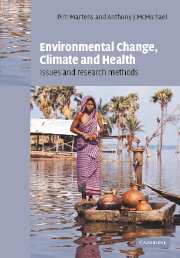Book contents
- Frontmatter
- Contents
- List of contributors
- Foreword
- 1 Global environmental changes: anticipating and assessing risks to health
- 2 Historical connections between climate, medical thought and human health
- 3 The contribution of global environmental factors to ill-health
- 4 Surprise, nonlinearity and complex behaviour
- 5 Epidemiological and impacts assessment methods
- 6 Retrospective studies: analogue approaches to describing climate variability and health
- 7 Detecting the infectious disease consequences of climate change and extreme weather events
- 8 Integrated Assessment modelling of human health impacts
- 9 Remote sensing, GIS and spatial statistics: powerful tools for landscape epidemiology
- 10 Monitoring the health impacts of global climate change
- 11 Epidemiology, environmental health and global change
- 12 Dealing with scientific uncertainties
- Index
- Plate section
- References
10 - Monitoring the health impacts of global climate change
Published online by Cambridge University Press: 28 July 2009
- Frontmatter
- Contents
- List of contributors
- Foreword
- 1 Global environmental changes: anticipating and assessing risks to health
- 2 Historical connections between climate, medical thought and human health
- 3 The contribution of global environmental factors to ill-health
- 4 Surprise, nonlinearity and complex behaviour
- 5 Epidemiological and impacts assessment methods
- 6 Retrospective studies: analogue approaches to describing climate variability and health
- 7 Detecting the infectious disease consequences of climate change and extreme weather events
- 8 Integrated Assessment modelling of human health impacts
- 9 Remote sensing, GIS and spatial statistics: powerful tools for landscape epidemiology
- 10 Monitoring the health impacts of global climate change
- 11 Epidemiology, environmental health and global change
- 12 Dealing with scientific uncertainties
- Index
- Plate section
- References
Summary
Introduction
As the processes of global environmental change proceed, the importance of monitoring health outcomes of climate change increases (e.g. Haines. et al, 1993; Haines, 1999). Accurate, reliable and comparable data are necessary for detecting and quantifying the early impacts of these changes on health, and as an essential first step towards planned adaptation to minimize adverse health impacts in a future, environmentally changed, world (McMichael et al., 1996; Balbus, 1998).
These issues are well illustrated by recent developments in relation to global climate change. This chapter developed from a report of a working group convened by the World Health Organization, European Centre for Environment and Health (WHO-ECEH), which prepared a background document for the Third Ministerial Conference on Environment and Health, held in London in June 1999. The document pointed to the need for the monitoring of potential impacts of climate change on human health, and highlighted the potential role of long-term integrated monitoring sites in investigating links between anthropogenic climate change, natural ecosystems and human health.
This chapter also draws on work of the NoLIMITS (Networking of Long term Integrated Monitoring Sites), preparatory action of the European Union ENRICH (European Network for Research in Global Change) programme. NoLIMITS aims to link current environmental monitoring sites throughout Europe, to make available policy-relevant scientific information to address environmental changes and their consequences at local to global scales, to provide a focus for collaborative interdisciplinary research between sites, networks and users, and to explore the possibility of introducing new measurements at existing monitoring sites to meet specific scientific and policy needs.
- Type
- Chapter
- Information
- Environmental Change, Climate and HealthIssues and Research Methods, pp. 253 - 289Publisher: Cambridge University PressPrint publication year: 2002

